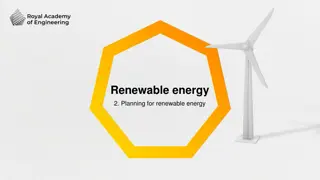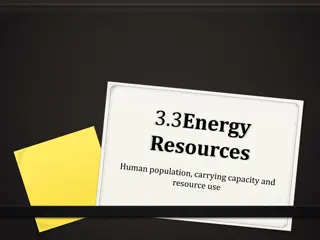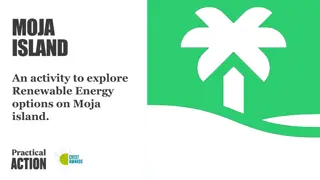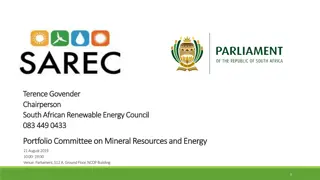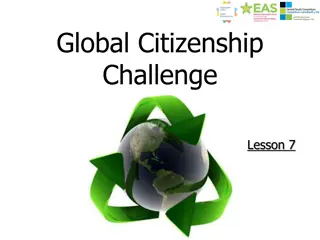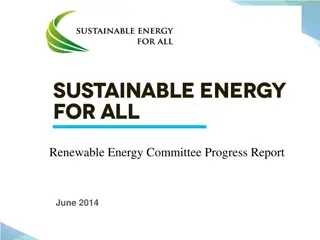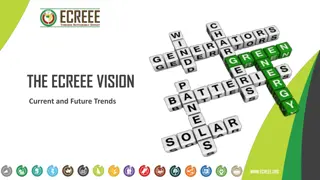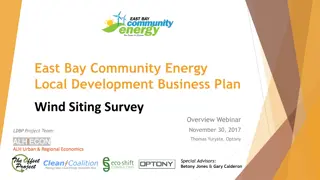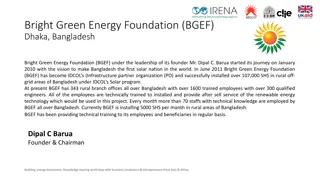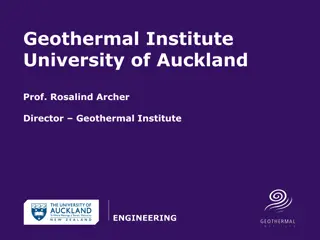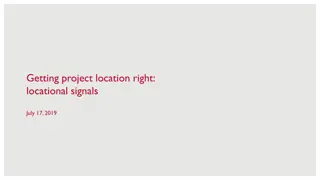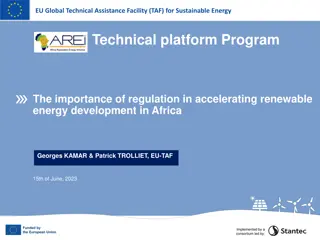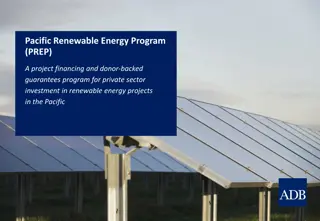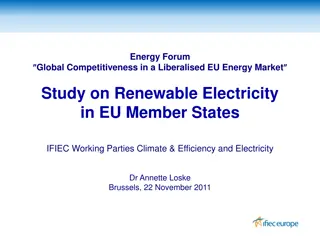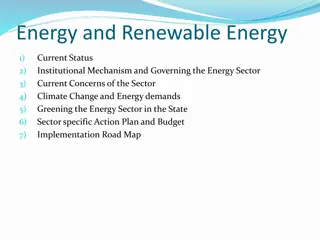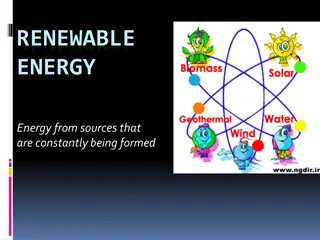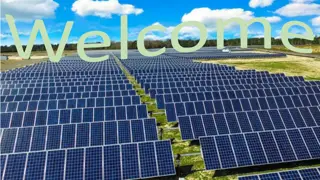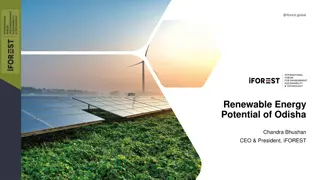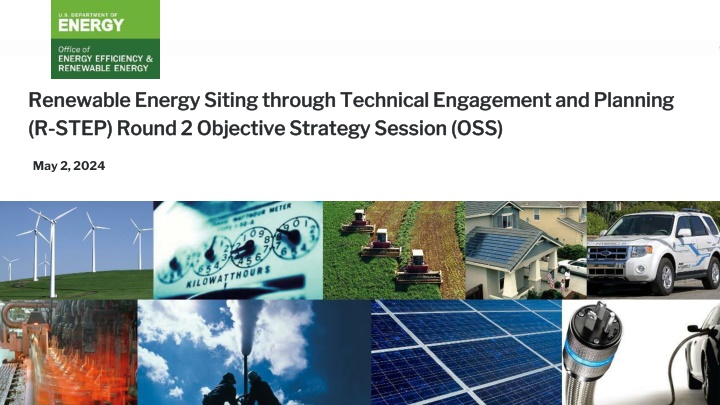
Renewable Energy Siting through Technical Engagement and Planning
Siting large-scale renewable energy facilities involves complex processes and engagement with host communities. This program by the U.S. Department of Energy aims to improve planning, siting processes, and outcomes through funding, technical assistance, and stakeholder engagement. It emphasizes community needs, resources, and collaboration to support local decision-making and enhance the renewable energy development landscape.
Download Presentation

Please find below an Image/Link to download the presentation.
The content on the website is provided AS IS for your information and personal use only. It may not be sold, licensed, or shared on other websites without obtaining consent from the author. If you encounter any issues during the download, it is possible that the publisher has removed the file from their server.
You are allowed to download the files provided on this website for personal or commercial use, subject to the condition that they are used lawfully. All files are the property of their respective owners.
The content on the website is provided AS IS for your information and personal use only. It may not be sold, licensed, or shared on other websites without obtaining consent from the author.
E N D
Presentation Transcript
Renewable Energy Siting through Technical Engagement and Planning Renewable Energy Siting through Technical Engagement and Planning (R (R- -STEP) Round 2 Objective Strategy Session (OSS) STEP) Round 2 Objective Strategy Session (OSS) May 2, 2024 1 U.S. DEPARTMENT OF ENERGY OFFICE OF ENERGY EFFICIENCY & RENEWABLE ENERGY
Agenda Agenda Background and program vision 1. Guidance on applications being requested 2. Timeline 3. How to apply 4. 2 U.S. DEPARTMENT OF ENERGY OFFICE OF ENERGY EFFICIENCY & RENEWABLE ENERGY
Stakeholder Engagement Informed Program Scope Stakeholder Engagement Informed Program Scope Key Engagement Takeaways Where and how large-scale renewable energy facilities are sited is a complex process that requires careful consideration of the host community s interests Opposition from host communities is challenging to address; trust dynamics play a key role State and local governments may lack the necessary staffing capacity (expertise & resources) EERE Role To improve large-scale renewable energy planning, siting processes, and outcomes for host communities, local governments, and renewable energy developers. 1. Provide fundingfor capacity expansion at state level 2. Provide technical assistance to institutionalize expertise 3. Disseminate achievements and convene interested stakeholders 3 U.S. DEPARTMENT OF ENERGY OFFICE OF ENERGY EFFICIENCY & RENEWABLE ENERGY
Program Vision and Approach Program Vision and Approach Funding Technical Assistance to Awardees Disseminate and Convene (Round 2 closes June 13) Establish or expand a state- level initiative that improves large-scale renewable energy planning, siting, and permitting Prioritize community engagement to identify needs Develop resources, trainings, and strategies to support local decision-making State-base collaboratives are cross-disciplinary with diversity in perspective and expertise Awardees eligible to receive additional TA from leading experts (separate from the project budget) One-on-one meetings with experts, awardee workshops, in-depth support with developing resources and scoping the program Peer-to-peer learning opportunities with other awardees As awardees execute projects, they will be highlighted on website and webinars Public webinars on various siting topics open to all stakeholders R-STEP website will grow as a go-to resource for siting 4 U.S. DEPARTMENT OF ENERGY OFFICE OF ENERGY EFFICIENCY & RENEWABLE ENERGY
Requesting Applications for Round 2 Requesting Applications for Round 2 Objective: To support state-based collaboratives (Collaboratives) aiming to expand state and local capacity for large-scale renewable energy planning and siting Can request up to $2 million to execute proposed activities over the duration of up to 3 years (36 months) Up to $12M total available A single application should be submitted by a lead applicant for each Collaborative Interested applicants should review Round 1 selections and assess existing renewable energy siting programs in their state before applying R-STEP will not support more than one application from a single state Collaboratives that applied but were not selected in Round 1 are eligible to reapply 5 U.S. DEPARTMENT OF ENERGY OFFICE OF ENERGY EFFICIENCY & RENEWABLE ENERGY
Application Considerations Application Considerations Focus on plans to establish or expand a state-level initiative that improves decision- making by state, local, and/or Tribal governments on large-scale renewable energy planning, siting, and permitting Prioritize community engagement both to identify local needs and disseminate technical resources Collaboratives should be cross-disciplinary with experience engaging local communities and technical expertise on siting issues Present a credible plan for the long-term maintenance of the initiative and resources developed with awarded funds (i.e., plans beyond the term of the R-STEP award) Focus on large-scale wind, solar, and battery energy storage infrastructure; may include activities related to other clean energy technologies, such as geothermal power, agrivoltaics, offshore wind, and electric vehicle charging infrastructure 6 U.S. DEPARTMENT OF ENERGY OFFICE OF ENERGY EFFICIENCY & RENEWABLE ENERGY
Possible/Example Activities (not exhaustive) Possible/Example Activities (not exhaustive) Engaging communities, local and/or tribal governments, and other stakeholders to identify renewable energy planning and siting priorities and resource needs, including through surveys or interviews. Developing state-specific resources to support community planning for renewable energy and implementation of siting best practices. Establishing a state-specific technical assistance hub that responds to questions and requests from local governments and/or tribes regarding large-scale renewable energy siting and proactive planning for future deployment. Conducting trainings and workshops with local governments and/or tribes to improve technical understanding of renewable energy planning and siting. Hiring or subcontracting to expand technical capacity on siting processes, renewable energy technologies, community engagement planning and execution, community plan development, etc. Conducting state-specific research and/or data collection to track trends in permitting timelines, community perceptions, zoning ordinances, etc., including use of machine learning models and software tools. 7 U.S. DEPARTMENT OF ENERGY OFFICE OF ENERGY EFFICIENCY & RENEWABLE ENERGY
Applications Specifically Not of Interest Applications that seek funding for a single specific local community. Applications focused on a single siting issue (e.g., wildlife impacts) Applications led by developers of renewable energy facilities, for-profit organizations, or national laboratories. Applications that focus on the siting and permitting of transmission infrastructure. Applications that focus exclusively on permitting of distributed energy sources or energy efficiency programs. Applications that propose to change siting or permitting policies in the state. Applications that focus solely on improving the siting and permitting processes conducted by federal agencies. 8 U.S. DEPARTMENT OF ENERGY OFFICE OF ENERGY EFFICIENCY & RENEWABLE ENERGY
Applicant Teams Applicant Teams Teams should include organizations 1. Familiar with the needs of local communities across the state 2. With experience providing educationalor technical assistanceservices to local communities (understand trust dynamics) and capable of reaching communities across the state 3. With technical expertise on renewable energy siting topics (e.g., environmental impacts, tax policies, zoning ordinance development) To facilitate the formation of teams, R-STEP is establishing an online Teaming Partner List where interested parties can express interest in potentially partnering with others. Same list as Round 1! 9 U.S. DEPARTMENT OF ENERGY OFFICE OF ENERGY EFFICIENCY & RENEWABLE ENERGY
Expectations for Awardees Expectations for Awardees Awardees will establish a business-to-business agreement with ENERGYWERX and define project activities (i.e., tasks, milestones, and deliverables) in a concise Statement of Effort (SOE) document Awardees will also be eligible to receive additional Technical Assistance (TA) from other leading experts, separate from the project budget Workshops, one-on-one meetings, cohort working sessions National labs, consultants, academics, and other experts Applicants must highlight topic areas where additional TA will be necessary Peer-learning and knowledge sharing is critical to success Cohort meetings and engagement with other awardees 10 U.S. DEPARTMENT OF ENERGY OFFICE OF ENERGY EFFICIENCY & RENEWABLE ENERGY
Timeline Timeline Milestone Round 2 Announcement/Applications Open Objective Strategy Session (OSS) Office Hours* Applications Close Selections Made/Awardees Notified Negotiations Projects Start Target Date April 17 May 2 May 22 June 13 (5pm ET) Late Summer Fall 2024 Fall/Winter 2024 * Sign up for office hours through the Ratio Exchange Website 11 U.S. DEPARTMENT OF ENERGY OFFICE OF ENERGY EFFICIENCY & RENEWABLE ENERGY
How to Apply How to Apply Applications will consist of an online questionnaire and a Project Narrative Click here to apply The questionnaire will have an option to upload a Project Narrative as an attachment Applicants must use the template provided and follow the Submission Guidance (all available on the EnergyWerx webpage) Maximum of eight pages, including cover page Note that this template was updated slightly from Round 1 Includes abstract in first page, new milestone table, and DEI Strategy section 12 U.S. DEPARTMENT OF ENERGY OFFICE OF ENERGY EFFICIENCY & RENEWABLE ENERGY



